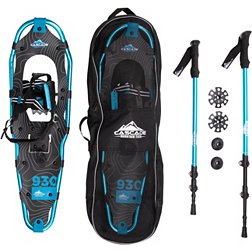Frequently Asked Questions About Snowshoes
Why do you need snowshoes?
Snowshoes are designed for winter weather conditions and make certain outdoor activities easier, including hiking, trail walking and running. They keep you from sinking into deep snow by distributing your weight evenly across the snow's surface.
What materials are used in snowshoes?
Snowshoes are usually solid composite shoes or constructed with aluminum frames and synthetic decking material. Both constructions have their advantages. Composite snowshoes are often more compact, making them better for icy surfaces and packed snow. Snowshoes with aluminum frames are ideal for deep powder because they offer better flotation to help prevent you from sinking. Tails can be added to composite styles to help improve their float.
Which size snowshoe should you buy?
Snowshoe size is based on your total weight, including both body weight and gear. If you weigh more, you'll need a bigger snowshoe.
What's the difference between men's and women's snowshoes?
Women tend to have a narrower stride than men, so their snowshoes are typically less wide to prevent any possible overlap. Also, like regular shoes, women's snowshoes are usually smaller than men's.
What shoes should you wear when snowshoeing?
You can wear anything from sneakers to snowboard boots, but snow boots or hiking boots are best. The more insulated and water resistant your boot is, the better off you'll be. You may want to factor in the weight of the snowshoe itself and opt for a lighter pair of boots. Remember to wear socks with good insulation and moisture-wicking materials to help keep your feet warm and dry.
What are common snowshoe accessories?
Trekking poles and gaiters are the most common snowshoe accessories. Poles help you keep your balance and provide additional support on ice and uneven terrain. A pair of gaiters will help keep you warm while keeping snow out of your boots. They also help protect your pant legs from catching on sharp objects.

























